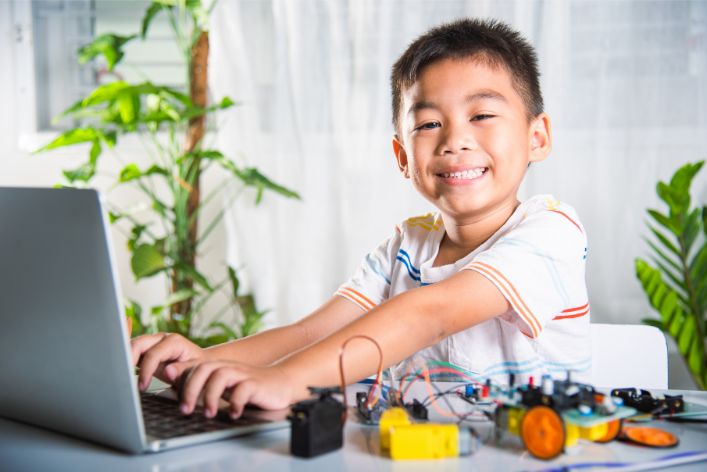Last Updated on May 4, 2023

Experiential learning, also known as “learning by doing,” is a form of education that emphasizes the importance of hands-on, real-world experiences as a means of enhancing student education.
Rather than relying solely on lectures and textbook readings, it seeks to engage students in active participation and reflection, allowing them to apply theoretical concepts to real-world situations.
In recent years, there has been a growing interest in the benefits of experiential learning, with educators and policymakers recognizing its potential to enhance student engagement, retention, and career readiness.
This article aims to explore the various benefits of experiential learning, including its ability to foster critical thinking skills, increase motivation and interest, and develop intercultural awareness and communication skills. In addition, this article will examine the different types, best practices for implementation, and potential challenges and considerations that educators and institutions must address.
Ultimately, this article argues that experiential learning should be an integral part of education, providing students with the necessary tools to succeed in both their academic and professional lives.
Benefits of Experiential Learning
This article explores the numerous benefits of experiential learning, including increased engagement and retention, preparation for the workforce, and the development of interpersonal skills. By highlighting the different types of best practices for implementation and potential challenges, this article demonstrates the importance of incorporating hands-on, real-world experiences into education.
1. Active Engagement and Participation
These are fundamental aspects of experiential learning that distinguish it from traditional forms of education. Active engagement involves the participation of students in their own learning process, where they take an active role in acquiring knowledge by seeking, processing, and organizing information.
This approach encourages students to reflect on their own experiences, ask questions, and make connections between theory and practice. By actively participating in their own learning, students are more likely to retain information, understand concepts more deeply, and develop a passion for learning that extends beyond the classroom.
Moreover, active participation in experiential learning allows students to learn from their mistakes, which is essential for developing critical thinking and problem-solving skills. In this approach, students are encouraged to take risks, make decisions, and solve problems in a safe and supportive environment. As a result, students are better equipped to navigate real-world challenges and develop the skills necessary to succeed in the workplace.
Active engagement and participation are crucial components of experiential learning that promote deeper education, critical thinking, and personal growth. By emphasizing the importance of student engagement, this provides a more holistic and personalized approach to education that enables students to develop a range of skills and competencies that are essential for success in today’s rapidly changing world.
2. Real-World Application and Relevance
Real-world application and relevance are key benefits of experiential learning that enable students to apply theoretical knowledge to practical situations in the real world. Experiential learning provides a more hands-on approach to learning that allows students to see the relevance of their studies to real-world issues and challenges.
This approach allows students to gain practical experience that can be directly applied to their future careers, making them more prepared and better equipped to tackle real-world challenges. It also helps students understand the practical implications of their studies, making their learning more meaningful and engaging.
By emphasizing the importance of real-world application and relevance, experiential learning enables students to develop a range of transferable skills that are essential for success in the workplace, including critical thinking, problem-solving, and communication skills. These skills are in high demand by employers and are critical for success in a rapidly changing and increasingly complex world.
Overall, real-world application and relevance are key benefits of experiential learning that make it a valuable tool for educators and students alike. By providing practical experiences that are relevant to students’ future careers, experiential learning enhances the learning process and provides students with the skills and knowledge they need to succeed in the real world.
3. Inclusivity and Diversity
Inclusivity and diversity are critical aspects of experiential learning that promote intercultural awareness, understanding, and communication. Experiential learning provides a unique opportunity for students to interact with people from diverse backgrounds, cultures, and perspectives, allowing them to broaden their horizons and develop a more inclusive and diverse worldview.
Inclusivity and diversity in experiential learning help students understand and appreciate different cultural perspectives, promote empathy, and reduce prejudice and bias. This approach creates a safe and supportive learning environment that encourages students to be themselves, express their opinions, and engage in productive dialogue with their peers.
By emphasizing inclusivity and diversity, it promotes cultural competence and prepares students to work effectively in a globalized world. It equips them with the necessary skills to communicate and collaborate with individuals from diverse backgrounds, enhancing their employability and preparing them for leadership roles in the future.
To sum it up, inclusivity and diversity are critical components of experiential learning that promote intercultural awareness, understanding, and communication. They create a learning environment that is welcoming, inclusive, and supportive, promoting student engagement, motivation, and success. This provides an opportunity for students to learn from diverse perspectives, enhancing their learning experience and preparing them for success in a globalized world.
Types of Experiential Learning
Many types of experiential learning can be used to enhance the educational experience of students. Here are some of the most common types:
1. Service-Learning: This type involves students engaging in community service activities that are related to their academic studies. Service-learning allows students to apply theoretical knowledge to real-world problems while contributing to the community.
2. Internships: An internship is an opportunity for students to gain work experience in their chosen field of study. Internships can be paid or unpaid and provide students with practical experience and exposure to professional environments.
3. Cooperative Education: Cooperative education involves students alternating between periods of academic study and periods of work experience related to their field of study. This approach provides students with an opportunity to apply what they have learned in the classroom to real-world situations.
4. Study Abroad: Study abroad programs allow students to immerse themselves in a foreign culture while studying academic subjects. This type of experiential learning promotes intercultural understanding and communication while providing students with a unique and memorable educational experience.
5. Simulation-Based Learning: Simulation-based learning involves the use of simulated or virtual environments to provide students with hands-on experience. This type of experiential learning is particularly useful in fields such as healthcare, aviation, and military training.
Overall, many types of experiential learning can be used to enhance the educational experience of students. Each type has its own unique benefits and challenges, and educators must carefully consider the needs of their students when selecting the most appropriate approach.
Challenges and Considerations
While experiential learning can provide many benefits for students, it also comes with its own set of challenges and considerations that educators must take into account. Here are some of the most common challenges and considerations for experiential learning:
1. Safety: Experiential learning often involves physical activities or real-world experiences that may pose risks to students’ safety. Educators must ensure that appropriate safety measures are in place and that students receive proper training and guidance to minimize the risks involved.
2. Logistics: This activity may require additional resources and logistical support, such as transportation, equipment, and facilities. Educators must carefully plan and coordinate these activities to ensure they run smoothly and effectively.
3. Assessment: Measuring the learning outcomes of experiential learning can be challenging, as these activities may not always result in tangible or measurable outcomes. Educators must develop appropriate assessment strategies that accurately measure students’ learning and progress.
4. Equity and Access: Experiential learning may be more accessible to certain students based on factors such as socio-economic status, race, or disability. Educators must ensure that these activities are inclusive and accessible to all students, regardless of their background or circumstances.
5. Integration: Experiential learning activities must be integrated into the overall curriculum in a meaningful and effective way. Educators must ensure that these activities align with learning objectives and are integrated into the broader educational experience of students.
Overall, it can provide many benefits for students, but it also comes with its own set of challenges and considerations. Educators must carefully consider these factors when designing and implementing experiential learning activities to ensure that they are safe, effective, and inclusive for all students.
Best Practices for Experiential Learning
When it comes to experiential learning, there are several best practices that educators can follow to ensure that their students get the most out of these activities. Here are some of the most important best practices for it:
1. Clearly define learning objectives: Before engaging in any experiential learning activity, educators must clearly define the learning objectives they hope to achieve. This ensures that the activity is aligned with the broader curriculum and that students understand the purpose and goals of the activity.
2. Plan carefully: These learning activities require careful planning and preparation. Educators must consider factors such as logistics, safety, assessment, and integration, as well as the needs and abilities of their students.
3. Provide guidance and support: Students may need guidance and support throughout the experiential learning activity. Educators should be available to answer questions, provide feedback, and ensure that students are on track to achieve the learning objectives.
4. Reflect and debrief: After the experiential learning activity is completed, it is important to reflect on the experience and debrief with the students. This allows students to process what they have learned, identify areas for improvement, and apply what they have learned to future situations.
5. Foster collaboration and teamwork: Experiential learning activities often involve collaboration and teamwork. Educators should encourage students to work together and develop their communication and collaboration skills.
Overall, following best practices can help educators ensure that their students get the most out of these activities. By carefully planning, providing guidance and support, and fostering collaboration and reflection, educators can create meaningful and effective experiential learning experiences for their students.
Future Directions for Research and Implementation
As experiential learning continues to gain popularity in the education sector, there is an increasing need for research and development to further enhance its effectiveness. Several areas of it require attention in future research, and these are briefly discussed below.
Firstly, there is a need to assess the effectiveness of different types of experiential learning in different contexts. While previous studies have established its benefits, more research is needed to determine which specific types are most effective in particular learning environments.
Secondly, developing best practices for the assessment and evaluation of experiential learning is crucial. As it becomes more widely adopted, it is important to establish clear and effective strategies for assessing and evaluating the effectiveness of these activities.
Thirdly, with the continued evolution of technology, there is an opportunity to explore how it can be used to enhance experiential learning activities and provide new opportunities for students. Integrating technology into it can provide students with innovative ways of learning and help create a more engaging and interactive learning environment.
Fourthly, there is a need to increase access and equity to experiential learning. While it can be an effective way to engage students who may not thrive in traditional classroom settings, efforts need to be made to ensure that these activities are accessible and equitable for all students, regardless of their background or circumstances.
Lastly, there is a need to integrate experiential learning into the broader curriculum. It should be viewed as an integral part of the broader curriculum rather than a standalone activity. Future research should explore how these activities can be integrated into existing courses and programs to enhance student learning.
Before you go…
Hey, thank you for reading this blog to the end. I hope it was helpful. Let me tell you a little bit about Nicholas Idoko Technologies. We help businesses and companies build an online presence by developing web, mobile, desktop, and blockchain applications.
We also help aspiring software developers and programmers learn the skills they need to have a successful career. Take your first step to becoming a programming boss by joining our Learn To Code academy today!
Be sure to contact us if you need more information or have any questions! We are readily available.











